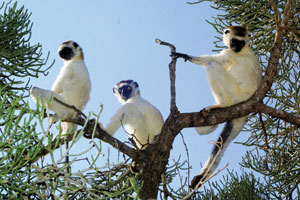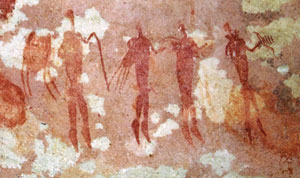San, safari and spa at Bushman’s Kloof
by Janie van der Spuy
For tens of thousands of years, the vast southern African plains were home to the wandering San people, or Bushmen. In small mobile tribes, they scoured the entire region, following the seasons in search of game, fruit and root crops. Today, what’s left of their fragile communities is restricted to the Kalahari Desert of Botswana. But throughout the entire area of Africa now bordered by South Africa, Botswana, Namibia, Zimbabwe and even Angola, their signature rock paintings mark the extent of their ‘empire’.
The Bushmen were gradually replaced by aggressive and expansionist agropastoralists like the Zulu, Xhosa, Swazi and Ndebele whose presence dates back little more than 2 000 years. These taller, stronger, darker-skinned tribes now predominate in the nations of southern Africa, relegating the San to the annals of history.
Located in the desert regions of South Africa’s Western Cape, a once devastated farming land is now fully restored to a world-class wildlife and botanical reserve. Today, the luxury Bushman’s Kloof Wilderness Reserve, now a South African Natural Heritage site, offers guests an unique wilderness experience, filled with potential enrichment, relaxation and outdoor adventures.
The reserve’s fauna is diverse, featuring over 35 species of mammals including the Eland and Bontebok, as well as nocturnal animals like the rare Aardwolf and Smiths red rock rabbit. All thrive on the property and roam freely. Bushman’s Kloof is justifiably proud of its 29 Cape mountain zebra (Equus zebra zebra), which rates as one of the largest privately owned herds of this endangered species. Current recorded numbers of this rare animal total only approximately 1200 beasts worldwide.
October 2004 saw the reintroduction of ten Kudu at Bushman’s Kloof, as well as the first pair of Brown hyena (Hyena borunea) - a small, shy and timid nocturnal scavenger that lives mainly on insects and plants, presenting no threat to humans. Guests are encouraged to interact closer with nature since they are able to walk and take mountain bike rides through the property, as well as participate in traditional game drives.
Sharing the mammals’ home are over 150 kinds of birds, including African fish eagle, the Malachite kingfisher and Black harrier, and many species of water birds. Seven species of indigenous ducks, such as Cape teal and Cape shovler were reintroduced to the area and established in the dams around the lodge, in an effort to lure more wild birds to the area, turning the lodge and reserve into a delight for bird watchers. Bushman’s Kloof is also working with a bird rehabilitation centre to assist with the release of injured and rescued Barn owls and Spotted eagle owls. Hacking cages and nesting boxes have been positioned and it is expected that the first eight owls will soon be released into the reserve. It is hoped that breeding will thus be encouraged and that this will lead to sightings of the owls around the property.
The natural botanical richness of Bushman’s Kloof include more than 755 indigenous plant species, representative of three major vegetation types: Fynbos, Forest and Karoo biomes. Each of these exists and thrives within this protected wilderness. Bushman’s Kloof has identified its own ‘Cederberg Seven’ - plant species unique to the area that are being established on the property, including four highly endangered species: Clanwilliam Cedar Tree (Widdringtonia cedarbergensis), Clanwilliam Aloe (Aloe comosa), Rocket pincushion (Leucospernum reflexum reflexum), and Snow Protea (Protea cryophila), as well as three other types of more common plants that are also unique to the area: Cedarberg vygie, Rooibos tea and the Clanwilliam sugar bush.
Additionally, a dynamic programme is in place to remove alien vegetation. In the last year, over six hectares of land was cleared of Port Jackson fig trees along the river systems, amounting to thousands of trees that will provide the lodge with sufficient firewood for all of 2005. The reserve management programme entails further reclamation and restoration of yet more old farmland and the re-vegetation of the area with indigenous grasses and shrubs for grazing purposes as well as erosion control.
Within the reserve’s boundaries, 270km from Cape Town, are over 130 remarkable Bushmen rock art sites. Guests have the opportunity to observe and learn about some of South Africa’s greatest national treasures. These ancient sites, located under overhanging cliffs and in rocky shelters, have been meticulously preserved and recorded, making them some of the finest examples of rock painting in all of South Africa. The Bushman’s Kloof Heritage Centre houses fascinating Bushman artefacts, including the highly acclaimed Rudner Collection and a series of historical photographs documenting the San culture.
Bushman’s Kloof Resort borders the Cederberg Wilderness Area, which as part of the Cape Floral Region was declared a World Heritage Site in 2004.
Voted the 5th Top Hotel in the World*, the 5-star Relais and Châteaux property offers luxurious and stylish accommodation, comprising of seven Luxury rooms, six Deluxe Rooms and three Suites - the Riverside Honeymoon Suite, as well as Niven and Paterson in the historic Manor House. The lodge also boasts 4 swimming pools (including one heated pool), a library and two bars.
To compliment a stay at this renowned resort, guests can also immerse themselves in a range of activities from luxury spa treatments to extensive outdoor pursuits including daily guided rock art excursions, evening nature drives, hiking and mountain biking, canoeing, archery, fishing, bird watching, croquet, stargazing and swimming in crystal clear rock pools. Guests may also take a stroll through the private botanical and organic gardens, including the unique San medicinal herb garden.
Bushman’s Kloof is a refreshing example of how a team of determined and visionary people can return virtual wasteland to an eco-tourism jewel that will serve as a benchmark for such properties, not only in the immediate region, but the world.
* USA Travel + Leisure Poll


